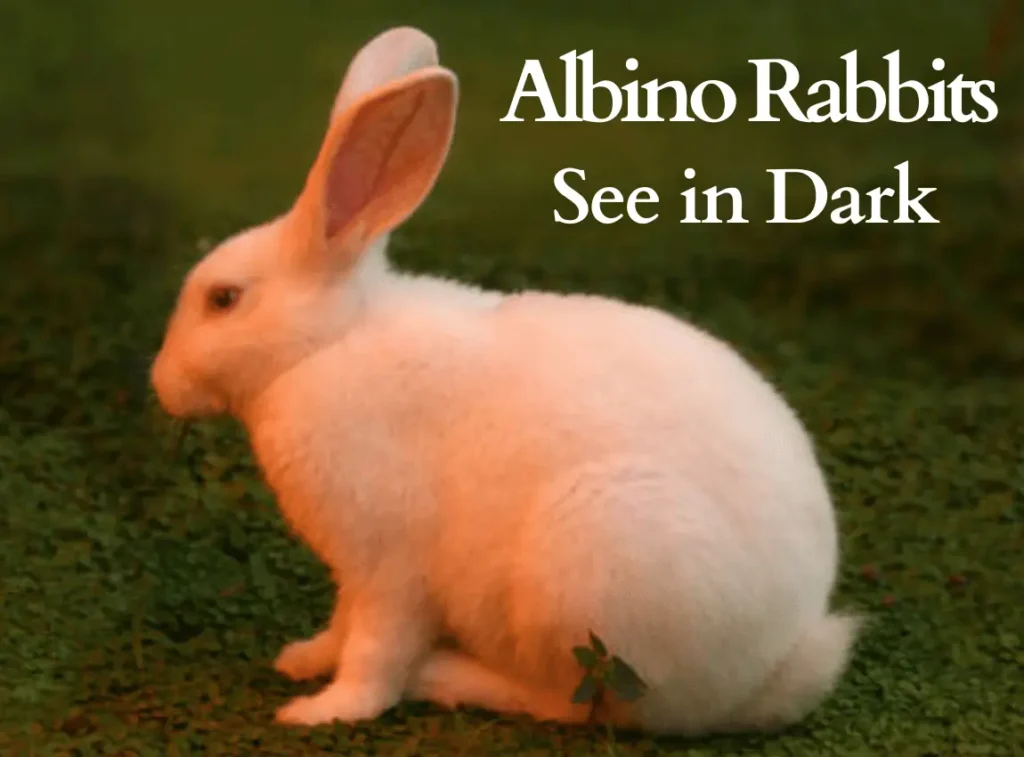This question is often asked that can albino rabbits see because this fascinating animal has a unique appearance pure white fur and striking red or pink eyes. Albino rabbits have this distinctive appearance due to a mutation in a gene that affects pigmentation. However, a lack of melanin can affect the rabbit’s vision. Understanding whether albino rabbits can see and how their vision compares to that of non-albino rabbits is essential for anyone interested in these animals.
Albino rabbits face several visual challenges due to their condition. Albino rabbits have a high sensitivity to light may have difficulty with depth perception and are at high risk for eye disease due to their lack of pigmentation. These factors raise important questions about their ability to navigate their environment recognize potential threats and interact with their surroundings.

This article explores the fascinating world of albino hare vision, the biological basis of vision, the challenges they face, and the behavioral adaptations they develop. By understanding the nuances of albino hare vision we can better understand this unique animal and provide the care and environment they need to thrive. So, can albino rabbits see? Let’s find out.
- Understanding Albinism in Rabbits Breed:
- The Basics of Rabbit Vision:
- Can Albino Rabbits See in the Dark:
- Albino Rabbits Go in the Sun:
- The Impact of Albinism on Rabbit Vision:
- Behavioral Adaptations of Albino Rabbits:
- Types of Albino Rabbits Eye Colors:
- Health and Care of Albino Rabbit Eyes:
- Take Care of Albino Rabbits:
- Conclusion:
- Frequently Asked Question:
Understanding Albinism in Rabbits Breed:
Albinism is a genetic disorder characterized by the absence of melanin the pigment that colors the skin, fur and red eyes of animals. In rabbits, albinism is caused by inheritance of a recessive gene from both parents. The lack of melanin makes the fur white and the eyes pink or red. The colour of the eyes is due to the presence of blood vessels in the unpigmented iris, giving them a unique appearance.
The Basics of Rabbit Vision:
To understand vision at albino rabbits see we must first understand the general visual abilities of rabbits. Rabbits have large laterally positioned eyes with a wide visual field which is important for detecting predators. This wide visual field is a key adaptation for rabbits to survive in the wild.
Visual Acuity:
Compared to humans, rabbits’ eyesight is not particularly sharp. They rely on their ability to recognize movement rather than detail. Their eyes are adapted to low-light environments allowing them to see better at dawn and dusk.
Color Vision:
Rabbits have dichromatic color vision which means they have two types of cone cells in their eyes blue and green. This limited color vision means that they cannot perceive the world as vividly as humans.
Can Albino Rabbits See in the Dark:
Albino rabbits have unique visual characteristics due to their lack of pigment which affects their ability to see in different lighting conditions. Here we will investigate that whether can albino rabbits see in the dark:

General Rabbit Vision Adaptations:
- Rabbits can generally see well in low-light conditions. This is due to the fact that they are nocturnal animals that is they are most active at dawn and dusk.
- Their eyes are adapted to low-light conditions allowing them to detect movement and orient themselves in low-light conditions.
Light Sensitivity:
- Albino rabbits lack melanin which protects the eyes from bright light. Therefore, they are sensitive to bright light and glare.
- Their high light sensitivity means they are more comfortable and see better in dark environments than in bright ones.
Night Vision Capabilities:
- Despite their sensitivity to light albino rabbits don’t have better night vision than non-albino rabbits.
- Their eyes are adapted to low light but not total darkness. They see better in low light than in total darkness.
Adaptations in Low-Light Conditions:
- Albino rabbits see better in the dark than non-albino rabbits but they rely more on other senses such as hearing and smell to find their way around.
- They see well at dusk and dawn because their larger eyes capture more light but this doesn’t improve their vision in total darkness.
Behavioral Adjustments:
- Albino rabbits may behave cautiously in poorly lit or dark environments due to poor eyesight.
- They may rely heavily on their sense of hearing and smell to detect predators or navigate their environment.
Providing a Suitable Environment:
- Owners should provide a well-structured environment with adequate lighting. Avoiding sudden changes from light to dark can help minimize stress in albino rabbits see.
- Shaded areas and dim lighting can create a comfortable environment suitable for their light sensitivity.
Albino Rabbits Go in the Sun:
Characterized by their white fur and pink or red eyes albino rabbits see lack melanin so you need to be careful when sunbathing. Read on to find out if your albino rabbit can sunbathe safely:

Sensitivity to Light:
- Albino rabbits see are very sensitive to light especially direct sunlight. They lack melanin which normally protects the skin and eyes from UV rays and are therefore more vulnerable to sunburn and eye damage.
- This increased sensitivity can lead to photophobia which causes discomfort and possible long-term damage with prolonged exposure to bright sunlight.
Risks of Sun Exposure:
- Skin burns: Skin burns can cause pain and increase the risk of skin cancer.
- Eye damage: The eyes are very sensitive to harsh light which can cause severe discomfort temporary blindness, or long-term damage such as cataracts and retinal degeneration.
Behavioral Considerations:
- Albino rabbits avoid strong direct sunlight and seek shady spots where they feel comfortable. This natural behavior protects them from the harmful effects of UV radiation.
Creating a Safe Environment:
- When keeping albino rabbits outdoors it is necessary to provide them with shaded areas where they can get away from direct sunlight. Shade cloths, trees or structures can be used to create these areas.
- Limiting their time in direct sunlight to early morning or late afternoon when the sun is less intense can also reduce the risk.
Protective Measures:
- Pets can be further protected by using sunscreen on sensitive areas such as the ears and nose. However, this should be done carefully and under the guidance of a vet.
- Regular skin and eye checks are essential to keep your pet healthy and if there is a problem you should consult your vet.
The Impact of Albinism on Rabbit Vision:
In albino rabbits see melanin deficiency affects many aspects of vision including light sensitivity, depth perception and overall clarity of vision.
Light Sensitivity:
One of the biggest challenges for albino rabbits see is their increased sensitivity to light. Melanin plays a key role in protecting the eye from ultraviolet (UV) light and reducing glare. Without melanin the eyes of albino rabbits see are more sensitive to the damaging effects of bright light. This condition known as photophobia causes discomfort and can cause them to squint or avoid brightly lit areas.
Depth Perception and Visual Clarity:
The lack of pigmentation in the iris also affects the ability of albino rabbits see to focus light precisely on the retina. This can cause them to see less clearly compared to non-albino rabbits. Albino rabbits may have problems with depth perception and may not be able to judge distances correctly. This can affect their ability to navigate their environment especially in unfamiliar or crowded places.
Eye Health:
Albino rabbits are also more susceptible to eye diseases such as cataracts and retinal degeneration. Over time these problems can further reduce vision so regular veterinary checkups are necessary.
Behavioral Adaptations of Albino Rabbits:
Despite these vision problems albino rabbits have developed a number of behavioral adaptations to cope with their unique vision. Understanding these adaptations is critical to their care and well-being.

Enhanced Hearing and Smell:
Like other rabbits, albino rabbits rely heavily on other senses like hearing and smell to compensate for their lack of sight. Albino rabbits have large sensitive ears that allow them to hear a variety of sounds helping them to recognize their surroundings and spot potential threats. They also have a well-developed sense of smell which helps them find prey and recognize familiar smells.
Cautious Behavior:
Albino rabbits tend to be more cautious and attentive than non-albino rabbits. This heightened vigilance helps them compensate for their visual deficiencies. They tend to move slowly and cautiously in unfamiliar environments and use their other senses to gather information before making decisions.
Preference for Low-Light Environments:
Due to their sensitivity to bright light albino rabbits often prefer dimly lit or shaded areas. An environment with plenty of shelter and shaded areas can help them feel more comfortable and reduce stress. The preference for low light is a natural adaptation to their light sensitivity.
Types of Albino Rabbits Eye Colors:
Albino rabbits are known for their characteristic lack of pigment which is reflected in their eye color. Although albino rabbits have predominantly red or pink eyes their appearance varies slightly due to underlying factors. Here is a more detailed look at the different eye colors of albino rabbits:

Red Eyes:
- Description: The most common eye color in albino rabbits. The red color results from the visibility of blood vessels in the iris due to the absence of melanin.
- Appearance: A bright striking red hue that can appear almost luminescent in certain lighting conditions.
- Commonality: This is the typical eye color seen in most albino rabbits and is the result of a complete lack of pigment in the eye.
Pink Eyes:
- Description: Another common variation in albino rabbits. The pink color is similar to red but tends to be lighter and less intense.
- Appearance: A softer more muted pink shade compared to the bright red eyes. The color can appear to change slightly depending on the lighting and angle.
- Commonality: Pink eyes are frequently seen alongside red eyes in albino rabbits, representing a similar lack of pigmentation but with a slight difference in the visibility of blood vessels.
Blue Eyes:
- Description: Rare in true albino rabbits but can occur in rabbits with partial albinism or specific genetic variations.
- Appearance: A light blue shade resulting from minimal pigmentation combined with the structural coloration of the eye.
- Commonality: Much less common than red or pink eyes. Blue eyes are usually indicative of some remaining pigmentation or a different genetic factor at play.
Health and Care of Albino Rabbit Eyes:
Regular Eye Examinations:
- Schedule regular veterinary check-ups to monitor for eye conditions such as cataracts and retinal degeneration which are more common in albino rabbits.
- Early detection and treatment of eye issues can prevent severe complications.
Managing Light Sensitivity:
- Provide a dimly lit environment to reduce discomfort from bright light.
- Ensure their living space has shaded areas where they can retreat from direct sunlight.
Protection from UV Rays:
- Minimize exposure to direct sunlight to prevent eye strain and damage.
- Use shade cloths or structures to create shaded outdoor areas if they spend time outside.
Clean and Monitor Eyes:
- Regularly check their eyes for signs of redness, discharge, or cloudiness.
- Gently clean around their eyes with a damp cloth to remove any debris or discharge.
Diet and Nutrition:
- Provide a balanced diet rich in antioxidants to support eye health.
- Include fresh vegetables, high-quality hay, and rabbit pellets in their diet.
Avoid Irritants:
- Keep their environment clean and free from dust and irritants that can affect their eyes.
- Avoid using strong chemicals or fragrances near their living area.
Veterinary Guidance:
- Consult with a veterinarian for any signs of eye discomfort or changes in vision.
- Follow veterinary advice on using pet-safe eye drops or other treatments if needed.
Take Care of Albino Rabbits:
Providing proper care for albino rabbits involves understanding their unique needs and making accommodations to ensure their well-being.

Environment and Housing:
Exposure to bright light should be kept to a minimum to create a suitable environment for albino rabbits. Enclosures should provide shaded areas and hiding places where rabbits can shelter from direct sunlight. Tunnels boxes and covered enclosures can help rabbits feel safe and comfortable.
Diet and Nutrition:
A well-balanced diet is essential for the overall health of albino rabbits. A variety of fresh vegetables, high-quality hay and rabbit pellets ensure that rabbits get the nutrients they need. A diet rich in antioxidants can also improve eye health and reduce the risk of developing cataracts.
Regular Veterinary Care:
Due to their increased susceptibility to eye disease it is important that albino rabbits are regularly examined by a vet. Routine eye examinations will detect the first signs of problems such as cataracts or retinal degeneration. Early intervention and treatment can significantly improve their quality of rabbits life.
Enrichment and Mental Stimulation:
Like all rabbits albino rabbits need mental stimulation and variety to stay happy and healthy. Toys, tunnels, and opportunities to explore can help keep your rabbit focused. Alternating toys and new challenges can help prevent boredom and promote mental health.
Conclusion:
Albino rabbits can see but their vision is affected by a lack of pigmentation. Due to their high sensitivity to light reduced vision and increased susceptibility to eye diseases they require special care and attention. By understanding their unique needs and taking appropriate measures owners can help these beautiful animals live a happy and healthy life.
Although albino rabbits can have vision problems they are resilient and adaptable animals. With the right care, attention and understanding they can thrive and continue to delight us with their unique appearance and gentle nature. The rabbit’s eyes story reminds us of the incredible diversity of the animal kingdom and the importance of compassion and care for all living things.
Frequently Asked Question:
Can albino rabbits see at night?
Albino rabbits can see in the dark but not in total darkness. They are adapted to low light but may have difficulty in very dark situations. Their vision is optimized for low light but not for total darkness.
Are albino rabbits sensitive to sunlight?
Yes, albino rabbits are very sensitive to sunlight. Their lack of melanin makes them more susceptible to sunburn and eye damage. It is best to provide them with shaded areas and limit their exposure to direct sunlight.
Can albino rabbits have blue eyes?
No, Albino rabbits have no pigmentation and usually have red or pink eyes. Blue eyes are not characteristic of rabbit albinism.
How rare are albino bunnies?
Albino rabbits are relatively rare compared with other color varieties. This condition is the result of a specific genetic mutation that makes them rare but very distinct among rabbit breeds.
What is the lifespan of an albino rabbit?
Like other domestic rabbits albino rabbits usually live 8-12 years. Their longevity depends on care including regular health checks by a veterinarian and a suitable living environment.
What do albino rabbits eat?
Albino rabbits have the same nutritional needs as other rabbits. They should be fed a balanced diet of fresh hay, vegetables and high-quality rabbit pellets to get the necessary nutrients.










